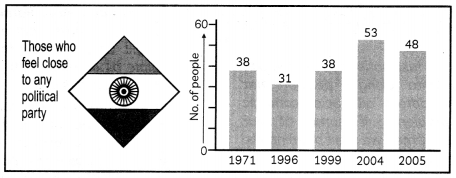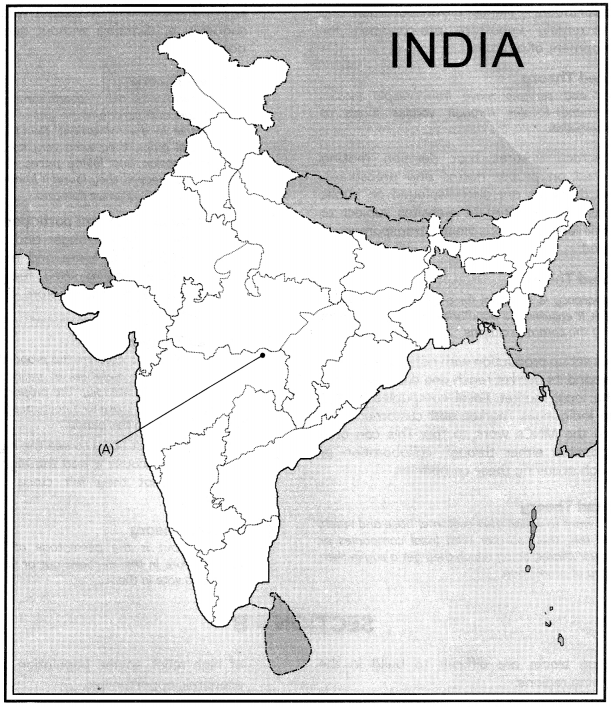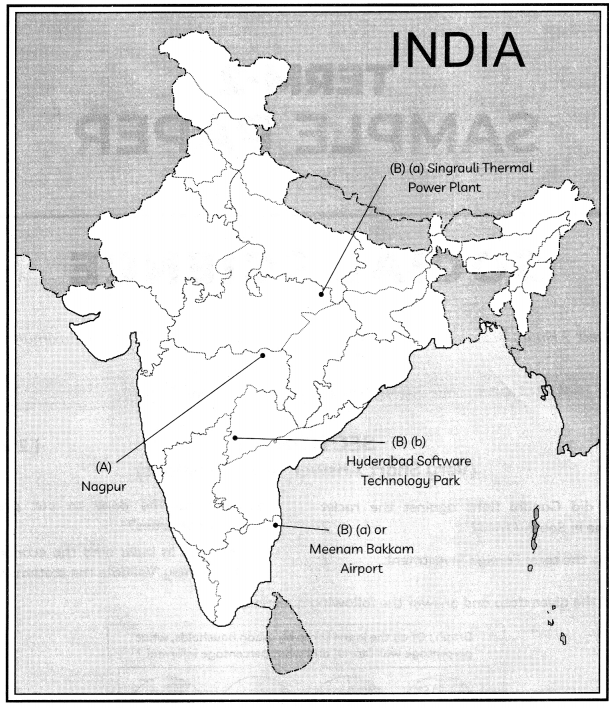Students can access the CBSE Sample Papers for Class 10 Social Science with Solutions and marking scheme Term 2 Set 5 will help students in understanding the difficulty level of the exam.
CBSE Sample Papers for Class 10 Social Science Term 2 Set 5 with Solutions
Time Allowed: 2 Hours
Maximum Marks: 40
General Instructions:
- This Question paper is divided into five sections-Section A, B, C, D and E.
- All questions are compulsory.
- Section-A: Question no. 1 to 5 are very short answer type questions of 2 marks each. Answer to each question should not exceed 40 words.
- Section-B: Question no. 6 to 8 are short answer type questions, carrying 3 marks each. Answer to each question should not exceed 80 words.
- Section-C: Question no. 9 and 10 are long answer type questions, carrying 5 marks each. Answer to each question should not exceed 120 words.
- Section-D: Question no. 11 and 12 are Case Based questions.
- Section-E: Question no. 13 is map based, carrying 3 marks with two parts, 13.1 from History (1 mark) and 13.2 from Geography (2 marks).
- There is no overall choice in the question paper. However, an internal choice has been provided in a few questions. Only one of the choices in such questions have to be attempted.
- In addition to this, separate instructions are given with each section and question, wherever necessary.
SECTION-A [2 × 5 = 10]
(Very Short Answer Type Questions)
Question 1.
Efficient means of transport is a prerequisite for fast development. What is the meaning of the given statement? (2)
Answer:
The given statement means that the pace of development of a country depends largely upon the movement of goods and services over space which is facilitated through transportation. Hence transportation is an extremely important pre-condition for development of a nation.
Related Theory:
Goods and services move from supply locales to demand locales through various forms of transportation.
Question 2.
How is transparency ensured in a democracy? (2)
Answer:
Democracy ensures that decision making is based on proper norms and procedures. These decisions are also displayed on public portals and government websites subject to the opinions of people. Hence, transparency is ensured.
Related Theory:
Transparency is essential for a democratic political system. It ensures the popularity of the government among the common citizens.
Question 3.
Why do MNCs set up production jointly with some of the local companies of these countries? (2)
Answer:
MNCs set up production with native companies to expand its market reach and customer base in the local market. Local companies have a huge indigenous market and customer base which the MNCs want to tap. This can only be possible either through collaboration or through acquiring these companies.
Related Theory:
MNCs want to widen their customer base and reach. To do this, they partner with local companies or buy their shares, doing which they get a say in their method of production.
Question 4.
Rich peasants supported the Civil disobedience movement initially. Mention one reason for their support. Why did they withdraw later? (2)
Answer:
The rich peasants supported the Civil disobedience movement to fight against high revenues which were collected by the British government. They were later disenchanted with the movement because it was called off suddenly by Gandhiji without achieving any goal.
Related Theory:
In the countryside, rich peasant communities – like the Patidars of Gujarat and the Jats of Uttar Pradesh were active in the movement. Being producers of commercial crops, they were very hard hit by the trade depression and falling prices. As their cash income disappeared, they found it impossible to pay the government’s revenue demand.
Question 5.
Study the data about political participation in India and answer the following questions.

(A) Interpret the trend of poLiticaL participation among Indian citizens ¡n the recent past. (1)
Answer:
The trend of political participation in India has been going stronger and upwards in the recent past. More and more people have been saying they feel closer to political parties than before according to the given table.
Related Theory:
Over the last three decades the proportion of those who report to be members of political parties in India has gone up steadily. The proportion of those who say they feel ‘close to a political party has also gone up in India in this period.
(B) If hypothetically, elections were held in oil the mentioned years, which year according to the given data ¡s most Likely to see the highest voter turnout In elections? (1)
Answer:
2004 is most likely to see the highest voter turnout because it had the highest people voting that they felt close to political parties.
Related Theory
Voter turnout is the percentage of people who actually vote in the elections out of those who are eligible to vote in them.
SECTION -B [3 × 3 = 9]
(Short Answer Type Questions)
Question 6.
Name a few regions which have extremely low densities of railway tracks? Explain the reasons behind the same. (3)
Answer:
Railway tracks are difficult to build in the following regions:
- Mountains and hilly regions
- Deserts
- Swampy and marshy lands of forests.
Free
Question 7.
How do SEZs act as important tools of the government to attract foreign investment?
OR
Economic activities require loans or credit. Do you agree? (3)
Answer:
SEZs or Special Economic Zones can provide economies with relatively open enclaves characterized by considerably free imports and exports of goods and services without duties and trade barriers. They have simplified customs procedures, fewer impediments on foreign ownership, as well as world class residential, educational, communication and transportation-related infrastructure and access to electricity. These regions attract foreign investors because of all these facilities. Foreign companies want to establish their factories and units in this region.
OR
Economic activities require loans or credit essentially because:
- Credit helps borrowers like industrialists, builders and developers finish their incomplete production and infrastructural construction works. That adds to their revenue.
- Credit encourages middle class people to undertake economic activities which people are hesitant to do otherwise. For example, opening a new entrepreneurial venture, buying a house, etc.
- Credit increases people’s incomes and profits. It helps to increase the production of goods and services and adds employment opportunities.
Question 8.
Gandhi said Satyagraha was not a physical force. A satyagrahi did not inflict pain on the adversary. Elaborate on the concept of Satyagraha as advocated by Gandhi. (3)
Answer:
Gandhi was a firm believer of the power of truth. He believed that Satyagraha is a pure soul force because truth is the substance of the soul. Gandhi believed Satyagrahis would never seek vengeance and would win battles through Non-violence. Satyagrahis would persuade people to see the truth and not force them to accept it through violence. Satyagraha according to Gandhi was the weapon of the strong and not the weak.
SECTION – C [5 × 2 = 10]
(Long Answer Type Questions)
Question 9.
If you were the head of a bank, how would you make loans more beneficial for poor farmers and workers? Suggest any five measures.
OR
Water pollution caused by industries must not be overlooked. State how is water pollution caused and support the given statement. (5)
Answer:
Formal sector loans can be made beneficial for poor farmers and workers in the following ways:
- I would lay out guidelines to create greater awareness among farmers about formal sector loans through interactive sessions and door to door banking.
- I would see to it that the process of providing loans be made easier. It should be simple, fast and quick.
- I would make sure more branches are opened in rural sectors.
- I would make sure to expand the lending capacities of my bank to reduce the dependence of people on informal sources of credit
- I will also ensure that formal credit is distributed more equally so that the poor can benefit from cheaper loans.
OR
Water pollution is caused by organic and inorganic industrial wastes and effluents discharged into rivers. This must not be overlooked.
- Paper, pulp, chemical, textile and dyeing, petroleum refineries, tanneries and electroplating industries let out dyes, detergents, acids, salts in water bodies. This can cause exceptional harm to aquatic life.
- Chemicals which are disposed off in water bodies and later consumed by the stray animals consume can affect their digestive system fatally.
- Heavy metals like lead and mercury pesticides, fertilisers, synthetic chemicals with carbon, plastics and rubber, etc. settle into the water bodies and destroy the biodiversity of marine ecosystems.
Question 10.
Parties shape public opinion. Validate the statement.
OR
Indian leaders began to look into the past to discover India’s greatest achievements. Why was this done? Support your stand by giving 3 points. (5)
Answer:
Political parties shape public opinions in the following ways:
- Political parties highlight social and political issues by bringing them up in their agenda and political manifestos.
- Political parties organize rallies and demonstrations educating the citizens about various burning social and political issues in the process.
- Party members and leaders organize debates, interaction related activities and campaigns to understand the issues of people living all over the country.
- Pressure groups and Interest groups are also extensions of these political parties and their formation is another testament to the moulding of public opinion with respect to a certain issue.
- Opinions in the society crystallise on the lines parties take when they launch movements for various issues.
OR
Indian leaders began to look into the past to discover India’s greatest achievement because:
- Indian leaders wanted the citizens to be proud of their rich heritage.
- Leaders believed that if they could make the citizens understand that they were capable of ruling themselves on their own as an independent nation, British would no longer be able to rule them.
- The British government had portrayed otherwise and were justifying their atrocious administration on the fact that Indians were primitive and backward and that they required some civilising.
- Indian leaders began reviving the glorious past of India in order to expose the hypocrisy of the British government and the exploitation they had carried out during their rule.
- In doing so, they were able to borrow the motivation to fight and struggle for their independence from examples mentioned in legends, stories and folktales.
SECTION-D [4 × 2 = 8]
(Case Based Questions)
Question 11.
Read the source given below and answer the questions that follow:
How do we assess democracy’s outcomes? Over a hundred countries of the world today claim and practice some kind of democratic politics: they have formal constitutions, they hold elections, they have parties and they guarantee rights of citizens. While these features are common to most of them, these democracies are very much different from each other in terms of their social situations, their economic achievements and their cultures. Clearly, what may be achieved or not achieved under each of these democracies will be very different. But is there something that we can expect from every democracy, just because it is democracy?
Our interest in and fascination for democracy often pushes us into taking a position that democracy can address all socio-economic and political problems. If some of our expectations are not met, we start blaming the idea of democracy.
Or
we start doubting if we are living in a democracy. The first step towards thinking carefully about the outcomes of democracy is to recognise that democracy is just a form of government. It can only create conditions for achieving something. The citizens have to take advantage of those conditions and achieve those goals. Let us examine some of the things we can reasonably expect from democracy and examine the record of democracy.
(A) Democracy is just a form of government. What does the statement mean? (1)
Answer:
The given statement means that it can only create conditions for development and encourage the people to fight for the same. Hence democracy is not responsible for our socio-economic development. It is only responsible to create a conducive atmosphere for our development. Explanation: Democracy can only create conducive conditions for development of the society. It cannot develop the society unless the people really want to facilitate these conditions and achieve holistic growth.
Related Theory:
For all communities to grow, multiple factors like country’s economic activity, growth, trade relations, opportunities for development are involved.
(B) Mention any two features common to all democratic countries. (1)
Answer:
Two common features in all democracies are as follows:
- They have formal constitutions.
- They hold elections.
(C) Do you think democratic also countries differ from each other in some way? Validate your stand. (2)
Answer:
No two countries can be exactly the same in terms of administration, or their historical evolution. All the democratic countries across the world are also different from each other in terms of the following factors:
- Social situations
- Economic achievements and activities
- their Cultures
- their social make-up
Question 12.
Read the given source below and answer the questions that follow:
But the most common route for MNC investments is to buy up local companies and then to expand production. MNCs with huge wealth can quite easily do so. To take an example, Cargill Foods, a very large American MNC, has bought over smaller Indian companies such as Parakh Foods. Parakh Foods had built a large marketing network in various parts of India, where its brand was well-reputed. Also, Parakh Foods had four oil refineries, whose control has now shifted to Cargill. Cargill is now the largest producer of edible oil in India, with a capacity to make 5 million pouches daily!
In fact, many of the top MNCs have wealth exceeding the entire budgets of the developing country governments. With such enormous wealth, imagine the power and influence of these MNCs! There’s another way in which MNCs control production. Large MNCs in developed countries place orders for production with small producers. Garments, footwear, sports items are examples of industries where production is carried out by a large number of small producers around the world.
(A) Define investments. (1)
Answer:
The money that is spent to buy assets such as land, building, machines and other equipment is called investment. For example, Foreign companies invest in the shares of Reliance or Tata Companies every year.
Caution
Answers with definitions should always be supplemented by examples.
(B) What are some ways for MNCs to control the production of local companies? (1)
Answer:
There are a variety of ways in which the MNCs are spreading their production and interacting with local producer companies in various countries across the globe.
- by using the local companies for supplies
- by closely competing with the local companies or buying them MNCs are exerting a strong influence on production at these distant locations.
(C) Which factors did Cargill Foods keep in mind while collaborating with Parakh Foods? (2)
Answer:
These are the factors which Cargill Foods kept in mind while collaborating with Parakh foods
- Parakh foods has an amazing access to local markets and their local consumer base is strong.
- Parakh foods own refineries which means easy availability of raw material
SECTION -E [1 × 3 = 3]
(Map Skill Based Questions)
Question 13.
(A) On the given outline Political Map of India, identify the place marked as A with the help of following information and write its correct name on the line marked near it.
(a) Identify the place where a session of Indian National Congress was held in December 1920. (1)
Answer:
Nagpur
(B) On the same given map of India, locate the following:
(a) Singrauli Thermal Power Plant
OR
Meenambakam Airport (1)
(b) Hyderabad Software Technology Park (1)

Answer:
(a) Singrauli Thermal Power Plant
OR
Meenambakam Airport
(b) Hyderabad Software Technology Park
